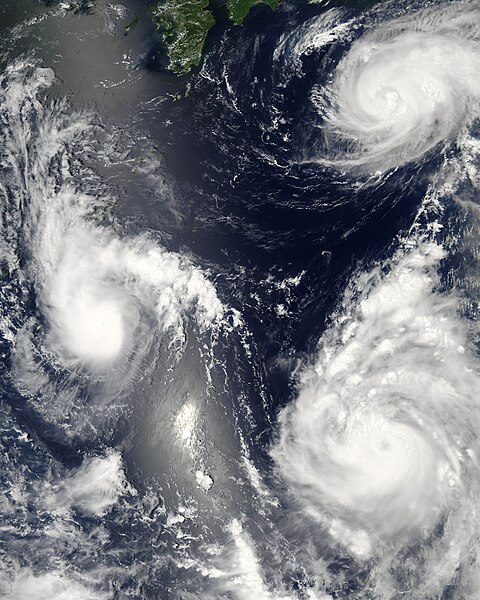tangan:Maria, Bopha and Saomai 2006-08-07 0435Z.jpg

pataayaway miazih hacica ku tabaki: 480 × 600 syangsu. u zuma katingalaw: 192 × 240 syangsu | 384 × 480 syangsu | 614 × 768 syangsu | 819 × 1,024 syangsu | 1,638 × 2,048 syangsu | 7,200 × 9,000 syangsu.
saayaway a tangan (7,200 × 9,000 syangsu, hacica ku tabaki nu tangan: 7.6 MB, MIME kakuniza: image/jpeg)
tangan nu nazipa’an
sapecec ku demiad/tuki sapiciwsace ku tuki nina demiad a tangan baziyong
| demiad/tuki | sukep tu zunga | ditek | misaungayay | pacunus sakacaay kapawan | |
|---|---|---|---|---|---|
| ayza | 2006年8月8日 (sakatusa a demied nu lipay) 11:06 |  | 7,200 × 9,000(7.6 MB) | Good kitty | == Summary == {{Information |Description=Three different typhoons were spinning over the western Pacific Ocean on August 7, 2006, when the Moderate Resolution Imaging Spectroradiometer (MODIS) on NASA’s Aqua satellite acquired this image. The strongest |
sakapaluwaluway nu tangan
isasaay kasabelih misiketkatukuh tina tangan:
sahamin-subal tangan pisaungay zasatu
isasa’ zuma Wiki masaungay tina tangan:
- ar.wikipedia.org ku pisaungay kalitemuhan kawaw
- az.wikipedia.org ku pisaungay kalitemuhan kawaw
- bg.wikipedia.org ku pisaungay kalitemuhan kawaw
- bh.wikipedia.org ku pisaungay kalitemuhan kawaw
- crh.wikipedia.org ku pisaungay kalitemuhan kawaw
- cs.wikipedia.org ku pisaungay kalitemuhan kawaw
- de.wikipedia.org ku pisaungay kalitemuhan kawaw
- en.wikipedia.org ku pisaungay kalitemuhan kawaw
- Typhoon
- Typhoon Saomai
- Tropical cyclone
- Wikipedia:Picture peer review/Archives/Archive2006
- User:Plasticup/MyFavorites
- Typhoon Maria (2006)
- User talk:Hurricanehink/Archive 23
- User talk:Thegreatdr/2012archive
- Wikipedia:Wikipedia Signpost/2013-11-20/Traffic report
- Wikipedia:Wikipedia Signpost/Single/2013-11-20
- Wikipedia:Top 25 Report/November 10 to 16, 2013
- User:Tfmbty/2006 Pacific typhoon season
- User:SongdaTalas/Archives of Former Articles
- en.wiktionary.org ku pisaungay kalitemuhan kawaw
- es.wikipedia.org ku pisaungay kalitemuhan kawaw
- fi.wikipedia.org ku pisaungay kalitemuhan kawaw
- hi.wikipedia.org ku pisaungay kalitemuhan kawaw
- id.wiktionary.org ku pisaungay kalitemuhan kawaw
- incubator.wikimedia.org ku pisaungay kalitemuhan kawaw
- ja.wikipedia.org ku pisaungay kalitemuhan kawaw
- ja.wikibooks.org ku pisaungay kalitemuhan kawaw
- ko.wikipedia.org ku pisaungay kalitemuhan kawaw
- lo.wikipedia.org ku pisaungay kalitemuhan kawaw
- ms.wikipedia.org ku pisaungay kalitemuhan kawaw
- my.wikipedia.org ku pisaungay kalitemuhan kawaw
- nn.wikipedia.org ku pisaungay kalitemuhan kawaw
- no.wikipedia.org ku pisaungay kalitemuhan kawaw
- pt.wikipedia.org ku pisaungay kalitemuhan kawaw
- ro.wikipedia.org ku pisaungay kalitemuhan kawaw
- ru.wikipedia.org ku pisaungay kalitemuhan kawaw
- th.wikipedia.org ku pisaungay kalitemuhan kawaw
- tk.wikipedia.org ku pisaungay kalitemuhan kawaw
- tr.wikipedia.org ku pisaungay kalitemuhan kawaw
ciwsace kina tanganay a yadah pulungamin pisaungay tu zasatu.




